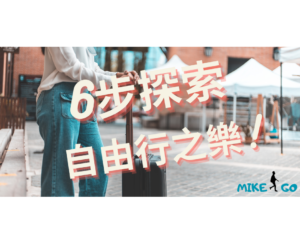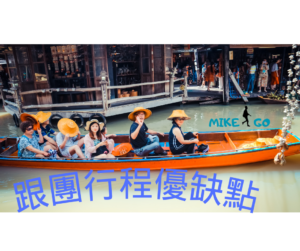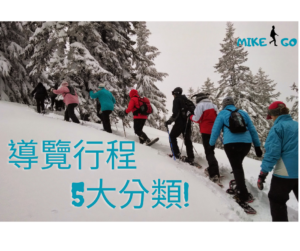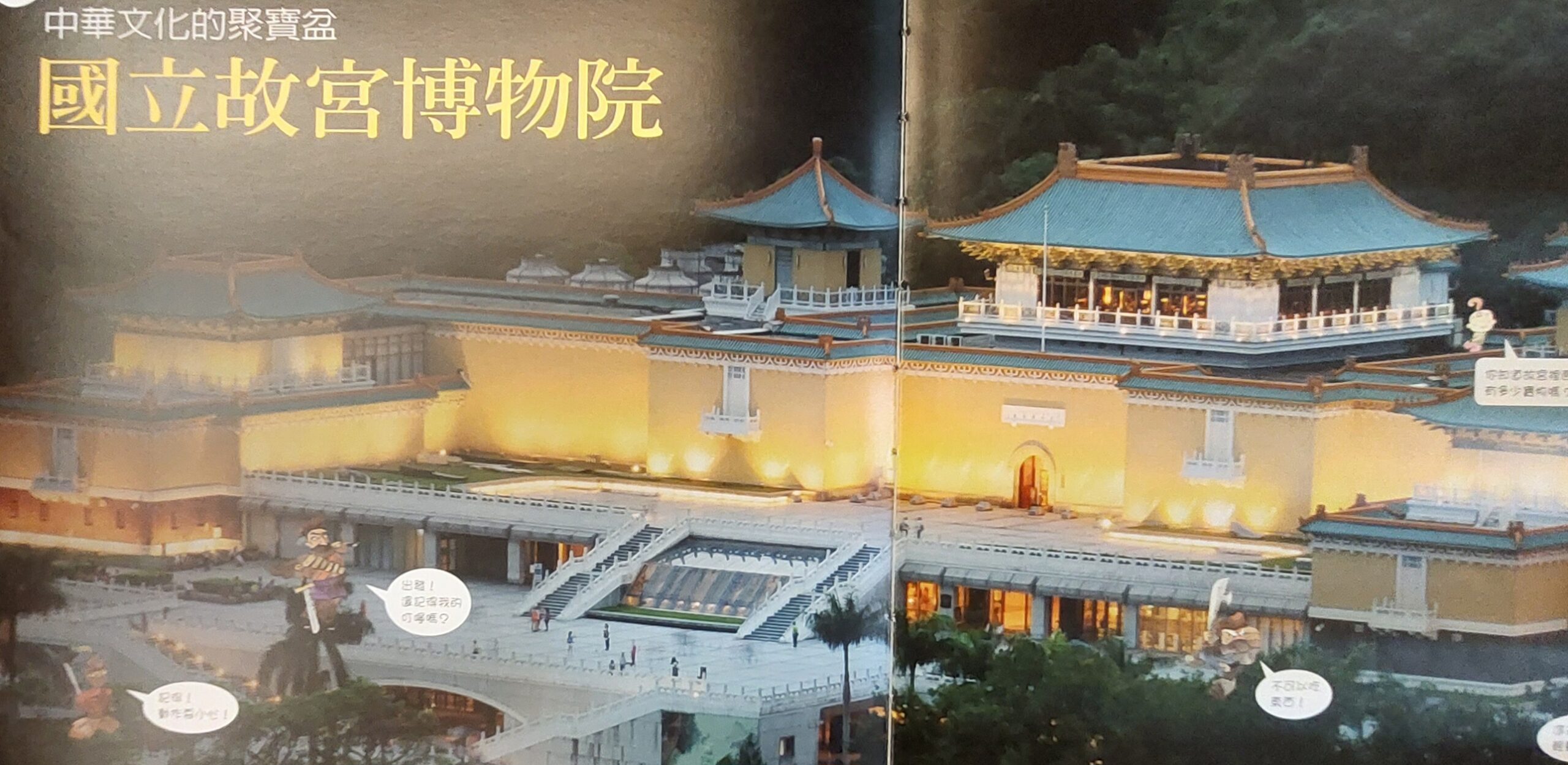

Practical Taipei National Palace Museum Classic Guided Tour 台北故宮經典導覽 31件文物
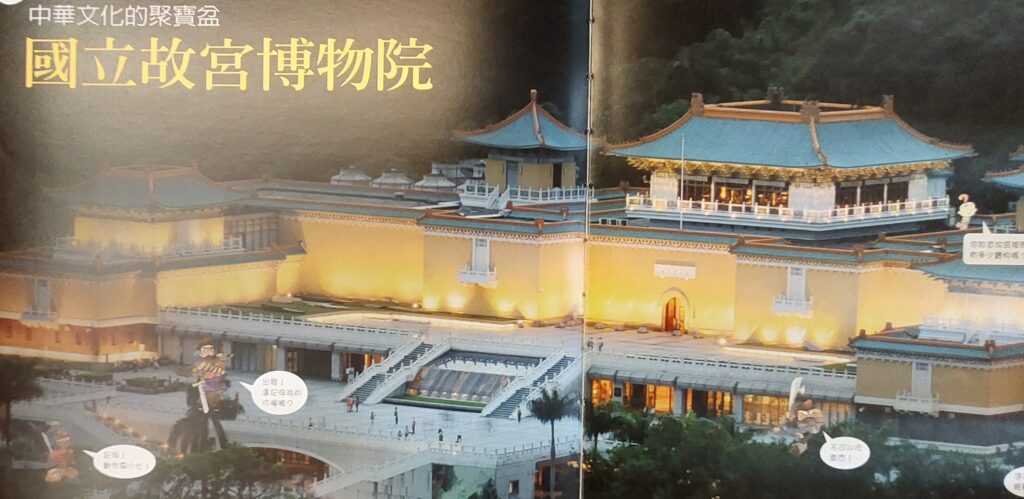

“The Taipei National Palace Museum” is a must-visit attraction for foreigners coming to Taiwan. As an English tour guide, it’s essential to learn how to lead foreign visitors in appreciating the museum’s classic exhibitions in the shortest amount of time. Here, I will share the information I’ve prepared in the hopes that it can be helpful to others.
台北故宮是外國人來台灣一定要去的景點,如何在最短的時間內,帶領外國人欣賞台北故宮的經典展覽品,是身為英文導遊一定要學會的功課,這裡把我準備得的資料和大家分享,希望也能對大家有所幫助。
Introduction to the Taipei National Palace Museum. 台北故宮博物院簡介
The National Palace Museum was completed in 1965, featuring Chinese palace-style architecture with exhibition spaces on the first to third floors. It houses the largest collection of Chinese art treasures in the world, primarily from the Song, Yuan, Ming, and Qing dynasties, covering nearly 5,000 years of Chinese history. The collection comprises nearly 700,000 items, earning the National Palace Museum the reputation of being the “Treasure House of Chinese Culture.”
國立故宮博物院於1965年落成,中國宮殿式的建築,一至三樓為展覽陳列空間。藏有全世界最多的中華藝術寶藏,收藏品主要來自宋、元、明、清四朝,幾乎涵蓋了整部五千年的中國歷史,數量近70萬件,使國立故宮博物院擁有「中華文化寶庫」的美名。
Klook.comThe Taipei National Palace Museum Classic Artifact Introduction Route – 3rd Floor 台北故宮博物院經典文物介紹路線-3樓
The standard operating procedure for the Taipei National Palace Museum, whether it’s a large group or a small group, is to recommend starting the tour from the 3rd floor. You can take the elevator from the back to the 3rd floor or use the central staircase to go up to the 3rd floor and then explore each level down to the 1st floor.
台北故宮博物院一般操作流程,不管是人數多的大團,還是人數少的小團,都建議從3樓開始導覽,可以從後方的電梯上3樓,或是直接從中間的樓梯上3樓,再逐層的逛下來到1樓。
3rd Floor – “Jadeite Cabbage” (1) 3樓-翠玉白菜(1)
Carved from verdant jadeite, purity of the white vegetable body, and brilliant green of the leaves all create for an endearing and approachable work of art. the two insects that have alighted on the vegetable leaves! They are a locust and katydid, which are traditional metaphors for having numerous children. This work originally was placed in the Forbidden City’s Yung-ho Palace, which was the residence of the Guangxu Emperor’s (r. 1875-1908) Consort Jin. For this reason, some have surmised that this piece was a dowry gift for Consort Jin to symbolize her purity and offer blessings for bearing many children.
是由翠玉所琢碾而成,潔白的菜身與翠綠的葉子,菜葉上停留的兩隻昆蟲,它們寓意多子多孫的螽斯和蝗蟲。此件作品原置於紫禁城的永和宮,永和宮為光緒皇帝妃子瑾妃的寢宮,因此有人推測此器為瑾妃的嫁妝象徵其清白,並企求多子多孫。


3rd Floor – “Meat-shaped stone” (2) 3樓-肉形石(2)
Certainly, after looking at the fresh cabbage for hot pot, of course, we need some meat in the hot pot. Take a look at this delicious piece of pork that has both the skin, fat, and lean meat. This meat-shaped stone is a perfect representation of braised pork, right down to its size, just like real pork. It makes you want to take a bite just by looking at it.
好的,看完火鍋料的白菜,當然火鍋裡要有肉囉。你看這 一塊好吃的豬肉要有豬皮、肥肉、和瘦肉,肉形石就是這樣完美的紅燒肉,連大小都和真實的豬肉一樣,看了真想咬一口。
The sculptor transformed an originally imperfect piece of amber into a work of art through imagination and skill. He meticulously carved out tiny holes on its surface to mimic pores, then dyed them a reddish-brown color, just like braised pigskin. It looks exactly like the real thing.
雕刻師把一顆原本不完美的琥珀,透過想像力和技術,他的表皮這些小洞,就是鑽出來模仿毛細孔,再染成褐紅色,就好像滷過的豬皮,真的一樣。
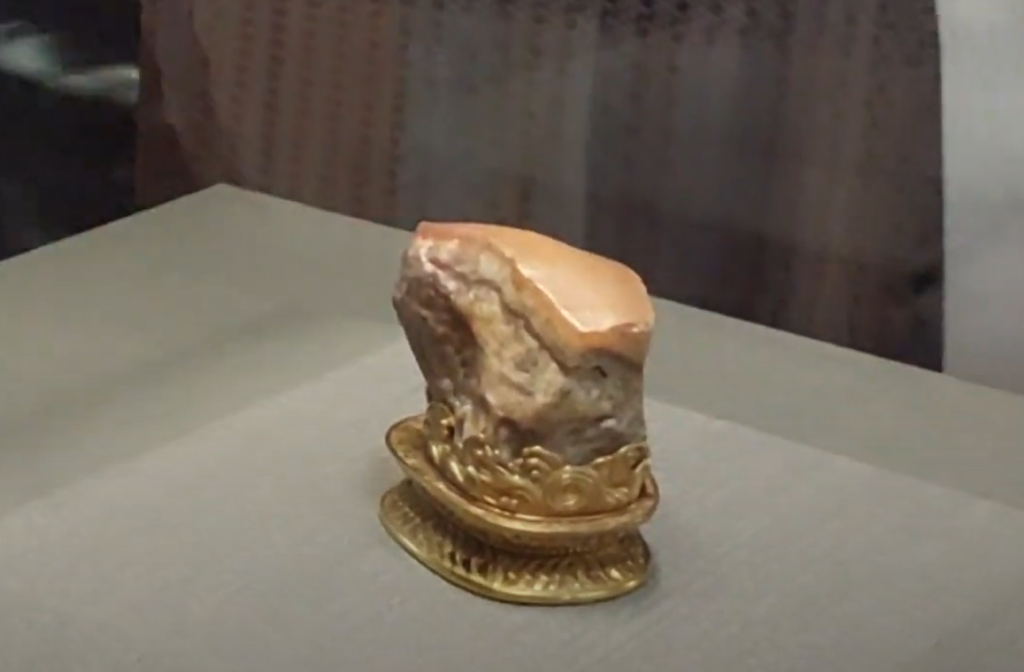

3rd Floor – “Introduction to Jade” 3樓-玉的介紹
Chinese people have a deep affection for jade, and this is widely known worldwide. Jade can be categorized into two main types: soft jade and hard jade. Soft jade has a warm texture, with Hetian jade from Xinjiang being considered the highest quality. Hard jade, on the other hand, is jadeite, known for its glassy luster, and it is primarily sourced from Yunnan and Myanmar.
中國人愛玉,全世界都知道,玉可以分軟玉和硬玉,軟玉質地溫潤,像來自新疆的和闐玉就是品質最好的。硬玉就是翡翠,有玻璃光的光澤,產地在雲南和緬甸。
3rd Floor – “Jade bi discs”(3) 3樓-玉璧(3)
Ancient people believed that jade possessed spiritual energy and could convey messages to the heavens. As a result, in the earliest times, people would use circular jade bi discs for celestial offerings and square-shaped jade cong tubes for earth offerings.
古人認為玉有靈氣,能幫人傳話給老天爺,所以最早期古人會以圓形的玉璧來祭天,用方柱體的玉琮來祭地。(天圓地方)
3rd Floor – “Jade cong”(4) 3樓-玉琮(4)
It looks like you’re referring to Taipei 101. It indeed resembles a jade cong with a circular hole piercing through its center, symbolizing “square on the outside, round on the inside,” representing an outward appearance of being square and straight while having a harmonious and balanced inner essence.
你看有沒有像台北101呢! 他就是玉琮,中間有圓孔貫通上下,象徵外方內圓,就是外表方正方直,但內心圓通。
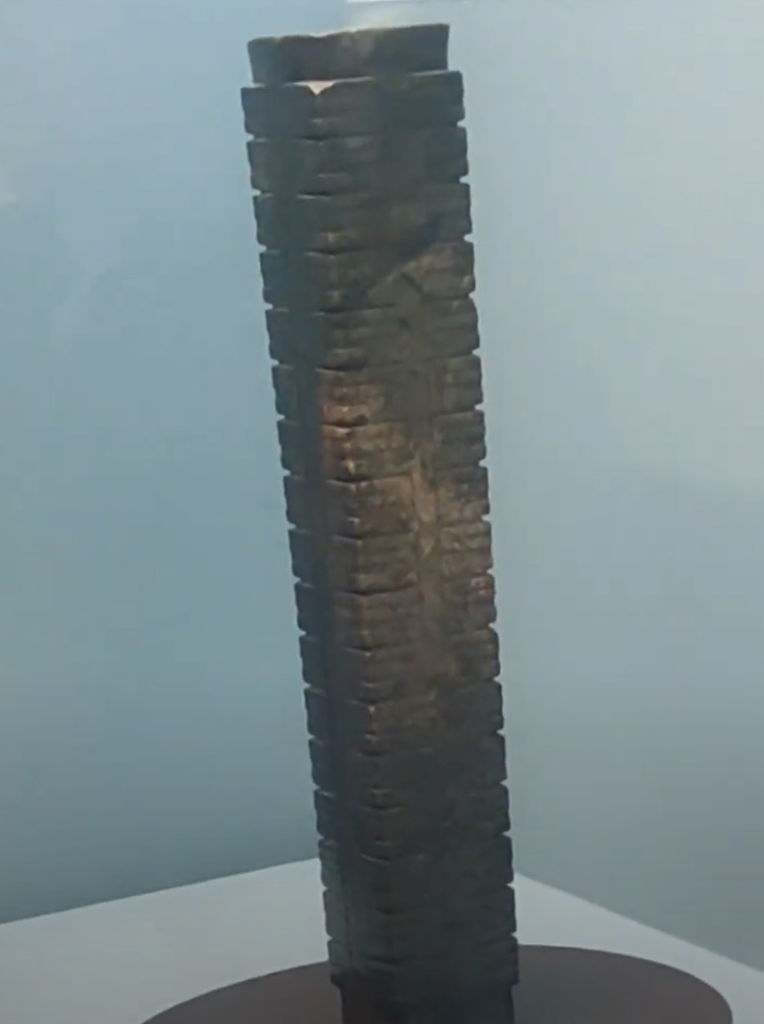

3rd Floor – “Introduction to DRAGON” 3樓-龍的介紹
The dragon is a legendary creature in ancient Chinese mythology, along with the phoenix, qilin, and tortoise, collectively known as the “Four Symbols.” Approximately 2,000 years ago, emperors began to refer to themselves as the “true dragon son of heaven,” and subsequently, the “five-clawed dragon” gradually became an exclusive symbol reserved for the emperor’s use.
龍是中國古代傳說中的靈獸,和鳳凰、麒麟、龜,和稱為四靈。大約2000年前,皇帝喜歡自稱是”真龍天子”,之後”五爪龍”漸漸成為皇帝獨家專用的象徵。
The image of the dragon underwent various changes in its early representations, with its current iconic appearance of the Chinese dragon being officially established after the Song Dynasty. The dragon’s body incorporates different features from various animals, including deer antlers, ox ears, rabbit eyes, snake neck, fish scales, and eagle claws.
龍的形象在早期多變,宋朝後才正式定型像現在大家印象中的中國龍的樣貌。龍身體各部分都像不同的動物,例如鹿角、牛耳、兔目、蛇頸、魚鱗、鷹爪。
3rd Floor – “Jade pig dragon”(5) 3樓-玉豬龍(5)
You see this thing called the “jade pig dragon,” does it look like a baby dragon to you? In reality, it looks more like a pig than a dragon.
你看這個叫玉豬龍,像不像嬰兒龍,其實看起來比較像豬,不是龍。
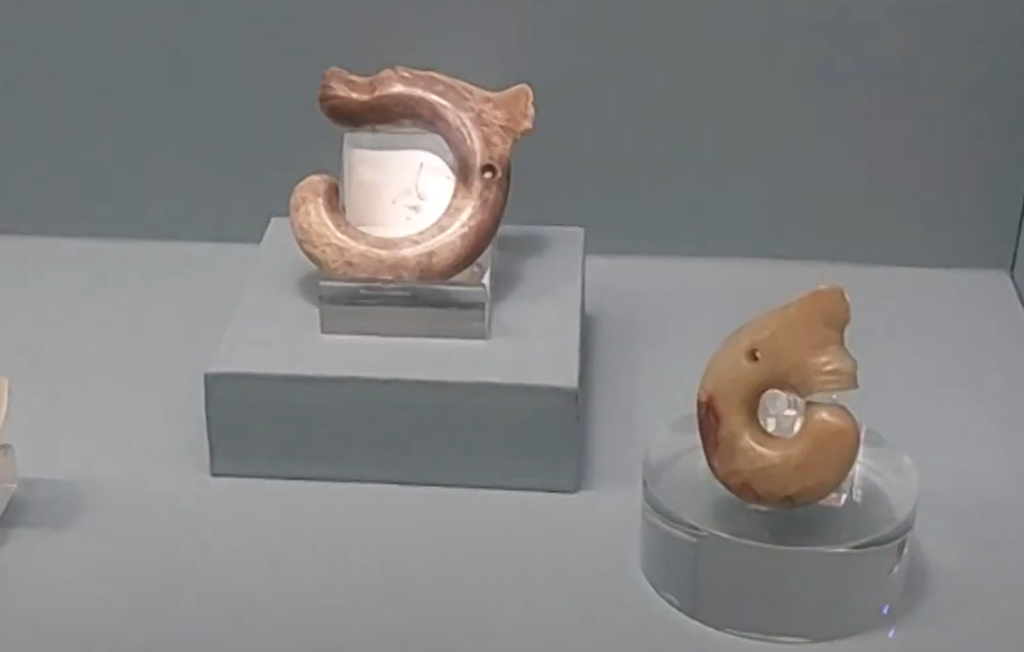

3rd Floor – “Dragon-Shaped Pendant”(6) 3樓-龍形珮(6)
The ancient people had a long-standing tradition of wearing jade pendants. Both nobles and scholars were fond of adorning themselves with jade pendants, and the higher their social status, the more jade jewelry they would wear.
古人很早就有珮玉的習俗,貴族和讀書人都流行佩戴玉珮,地位越高,佩戴的玉飾就越多。
Klook.com3rd Floor – “Jade Cup”(7) 3樓-玉杯(7)
Ancient people believed that fine jade was rich in “essence” and held the belief that material objects could have a resonance effect. During the Han Dynasty, nobles placed special importance on containers made of jade. They hoped that the essence of jade would permeate the water or wine stored within, allowing those who consumed it to achieve immortality and enlightenment.
古人相信美玉富含「精氣」,更相信物質會產生感應作用。漢代的貴族特別重視玉製的容器,他們希望玉的精氣能滲入所盛裝的水或酒中,令飲者能成仙得道。
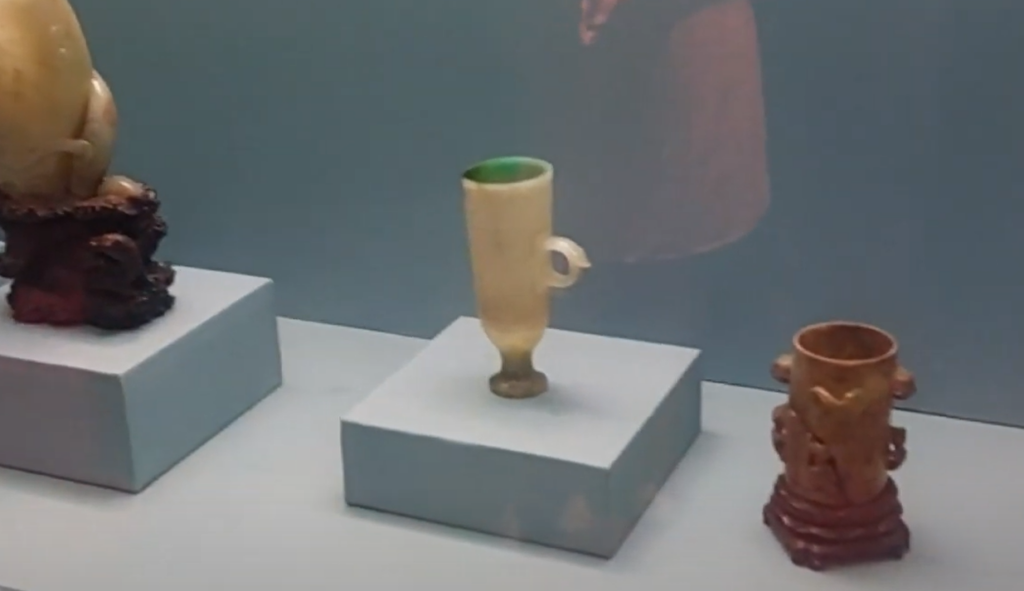

3rd Floor – “Jade cicada”(8) 3樓-玉蟬(8)
In terms of their purposes, there are three types of jade cicadas: one is the “wearing cicada,” worn as a decoration and for protection against evil; another is the “crown cicada,” attached to hats as an ornament; and the third is the “buried cicada,” specifically placed in the mouth of the deceased as a burial item.
就其用途來說,玉蟬有三種類型:一種為佩蟬,佩帶身上裝飾和避邪;一種為冠蟬,繫於帽子上作飾物;還有一種為含蟬,是專放置死者口中的隨葬品。
People believed that cicadas burrowed into the earth from trees during the cool autumn, and when spring arrived with its warm weather and blooming flowers, they emerged from the ground and climbed back up the trees. This cycle of renewal and rebirth symbolized eternal life. Therefore, placing a jade cicada in the mouth of the deceased was symbolic of the cicada guiding them to rebirth.
人們認為蟬在秋涼之時從樹上鑽入土中,等春暖花開之時,再從土中鑽出爬上樹,能夠周而復始,生生不息,因此死者口含玉蟬寓意為由蟬引路而獲得重生。
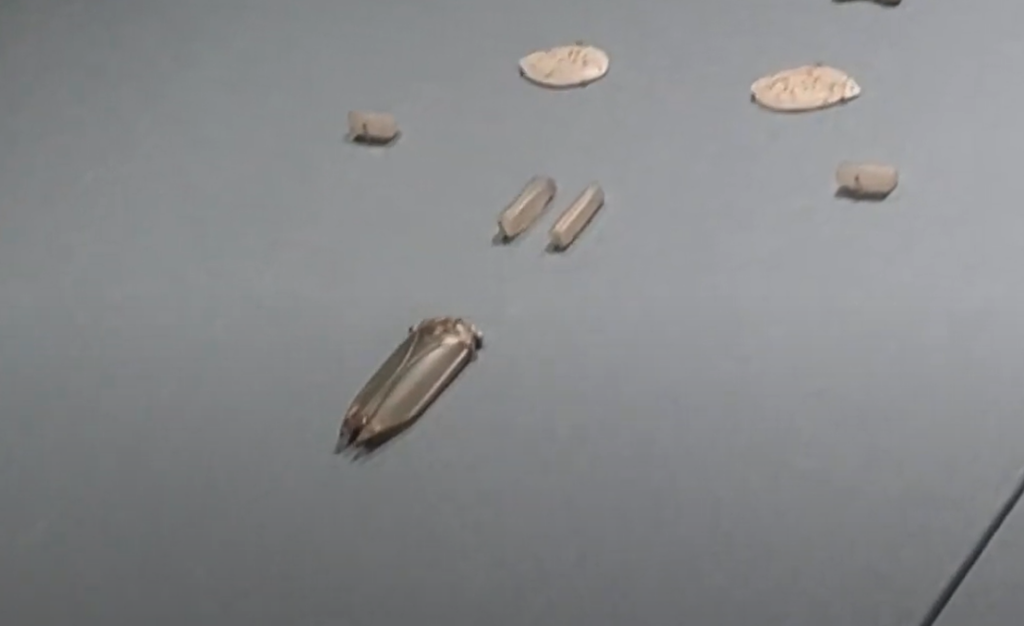

3rd Floor – “Jade Goblet”(9) 3樓-玉爵(9)
A drinking vessel with the symbol of longevity.
具有長壽意象的飲酒器具。
3rd Floor – “Jade Goblet”(10) 3樓-碧玉屏風(10)
The largest item in the National Palace Museum, measuring approximately 188 centimeters in height, over 33 centimeters in width, and adorned with 48 large jade panels, is the “Jadeite Cabbage Screen.”
故宮中體積最大的,它的高度約一百八十八公分、寬超過卅三公分、並鑲有四十八塊大玉片。這器物就是「碧玉屏風」。
When the cultural relics from the National Palace Museum were being transported from Nanjing to Taiwan, on the last ship filled with artifacts, Mr. Hang Liwu indicated that there were four more crates of relics to be loaded. These four crates contained artifacts that were brought back from Japan after the victory in World War II. Their value lay not only in the relics themselves but also in the achievement of victory in the war, making them priceless. Since there was no space left on the ship for these four crates, they had to be loaded into a special compartment reserved for government officials, where tables and other items were removed to make room for them. This is how the large “Jadeite Cabbage Screen” was among the artifacts transported to Taiwan in these four crates.
當年故宮文物從南京要運送到台灣,當最後一班船裝滿文物後,但是杭立武先生卻表示還有四箱文物要上船,這四箱文物就是在抗戰勝利後從日本拿回來的,其價值不僅是文物本身,也是抗戰勝利的成果,因此價值連城。這四箱文物上船後根本沒有可容之處,只好進入政府官員專用的船艙,撤掉桌子等物,騰出空間,才得以裝載後運送至台灣。在這四箱文物中就有這個體積甚大的「碧玉屏風」。
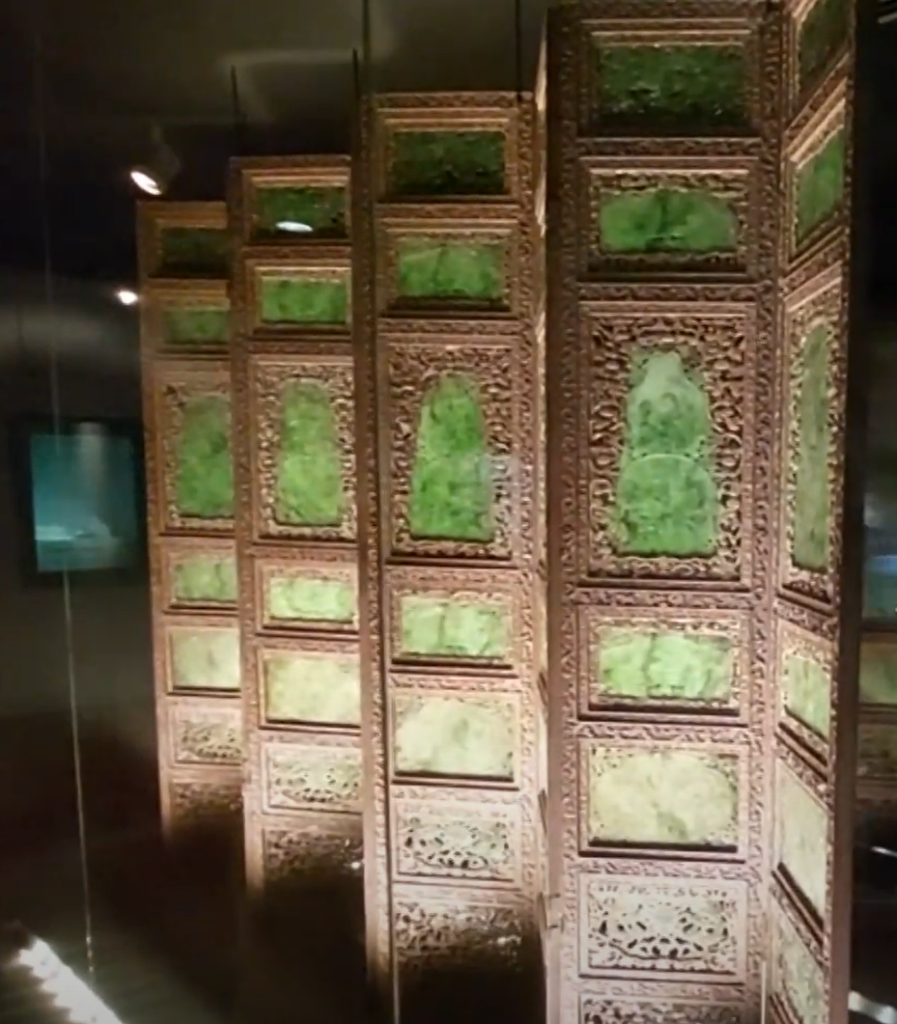

3rd Floor – “Introduction to Bronze” 3樓-青銅器的介紹
Bronze is a metal alloy composed of copper, tin, and lead. In ancient China, bronze was used as ceremonial vessels for ritual purposes, often inscribed with inscriptions or texts.
青銅器,是由銅、錫、鉛,合成的金屬,在古代中國青銅器是用來作為祭祀典禮上的禮器,並在上頭刻上文字。
In ancient times, they were exclusively used by the nobility.
古代只有貴族能使用。
Bronze items that are cast from steel are initially golden in color. Over time, as they are buried underground and subjected to the effects of rust and corrosion from soil and water, they gradually turn into a greenish-blue hue.
鋼鑄好的青銅器是金黃色的,因為長時間被埋在地下,經過水土鏽蝕,才變成青蒼色。
3rd Floor – “Maogong Ding”(11) 3樓-毛公鼎(11)
A “ding” is a cooking vessel, typically used for boiling meat. However, the “Maogong Ding” is not used for cooking food; it is a precious ceremonial vessel used in rituals and ceremonies.
鼎,就是煮肉的鍋子,但是毛公鼎不是用來煮食物的喔,他是祭祀時使用的珍貴禮器。
The “Maogong Ding” is known as the treasure of the museum because it bears an inscription of 500 characters inside, which is the most extensive among all the bronze artifacts in the collection.
毛公鼎被稱為鎮館之寶,是因為它裡面鑄刻了500字銘文,是所有館藏青銅器中最多的。
When King Xuan of the Zhou dynasty ascended the throne, he sought to revitalize the state and invited his uncle Mao Gong to assist with governance. He admonished him to be diligent and selfless in serving the country. Mao Gong felt deeply honored and, in commemoration of this event, cast this ding, recording the story with the hope that it would be cherished by future generations.
周宣王剛即位時,想振興國事,請他的叔父毛工來輔佐政事,訓勉他要勤勉無私,為國效力。毛公覺得很榮耀,便鑄造了這個鼎,記錄下這件事,希望子孫永久珍藏。
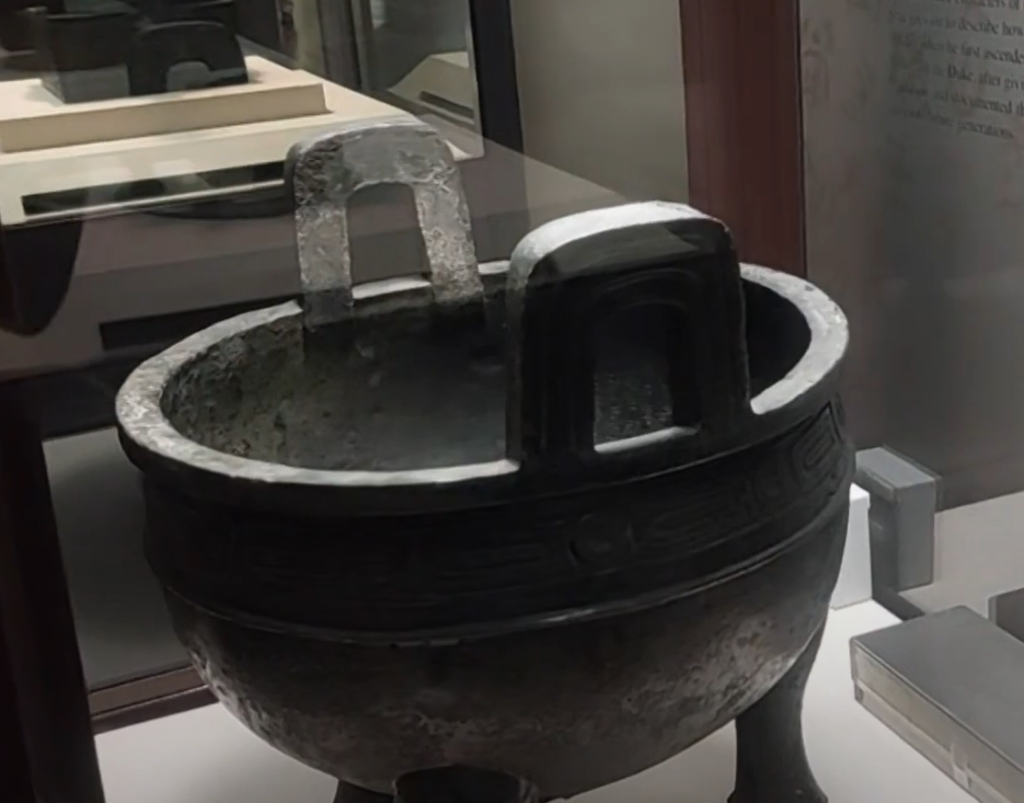

3rd Floor – “Zong Zhou Bell”(12) 3樓-宗周鐘(12)
Do you see any resemblance to a hedgehog here? In fact, this is a type of musical instrument used for rituals. Its shape is pointed and flattened on both sides, and when you strike the center and the edges, it produces precise two different tones. By suspending bells of different sizes according to their pitch, you can assemble a set of chimes, allowing you to create beautiful music when struck.
你看這有沒有長得像刺蝟,事實上他是一種祭祀用的樂器,它的形狀兩邊尖扁,當你敲中間和邊角,能敲出精準兩個音。只要把大小不同的鐘,依照高低音懸掛起來,組成編鐘,就能敲出好聽的樂曲了。
3rd Floor – “Human-Footed Beast-Shaped Container”(13) 3樓-人足獸鋬匜(13)
You can see a mythical creature sipping water surreptitiously here. This creature is bent over, serving as the handle of the vessel. Four small figures are positioned beside it, serving as four legs, thus transforming it into a container for holding water. It was used for handwashing during rituals or banquets before and after the event.
你看有怪獸在偷喝水,這怪獸的彎著身體攀在上面,就變成了把手,旁邊四個小人頂著,就變成了四個腳,變成了一個裝水的容器,在祭祀或宴會前後讓人洗手。
3rd Floor – “Metal Wire Libation Vessel”(14) 3樓-金屬絲犧尊(14)
Do you notice the resemblance to a horse’s muzzle here? In reality, this is a wine vessel from the Warring States period. Its mouth serves as a spout for pouring wine, and there is an opening on its back that can be opened to pour wine into it.
你看這個有像馬來膜嗎? 其實他是戰國時期的酒器,他的嘴巴就是倒酒流出的口,背上開口可以打開倒酒進去。
3rd Floor – “Sanpan”(15) 3樓-散盤(15)
This is called a “sanpan.” The “pan” refers to the water-receiving vessel. As we saw earlier, there was a container for handwashing and pouring water. Typically, these two items are used together.
這個叫散盤,盤是接水器,我們剛剛有看了洗手倒水的容器,通常兩個會搭在一起使用。
However, this “sanpan” is not just a vessel; it is, in fact, one of the earliest land treaty documents. It contains a 350-character inscription that records the failed invasion of the state of San by the state of Cao during the Zhou Dynasty, ultimately resulting in a land concession agreement.
但這個散盤不只是一個器皿,其實他還是最早的一件土地合約喔,裡面有銘文350個字,紀錄了周朝夨國偷襲散國失敗,結果最後割地求和的合約。
Haha! This contract couldn’t be altered, let alone torn apart; it’s one of the most substantial documents from ancient times. It weighs 21 kilograms.
哈哈! 這份合約無法更改,更不能撕毀,是古代最有份量的文件。他重21公斤。
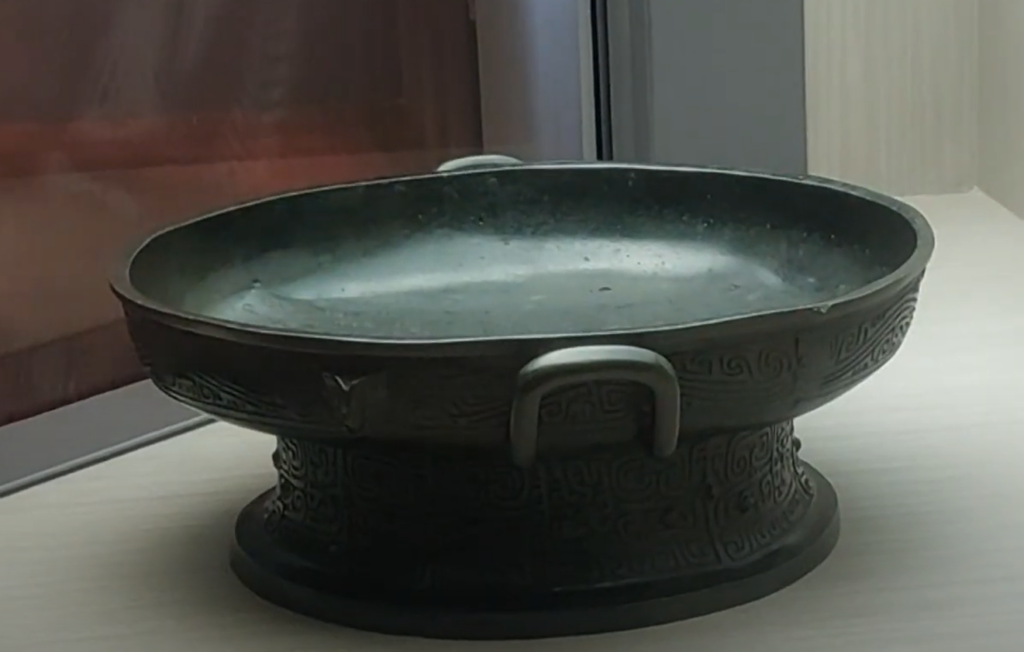

The Taipei National Palace Museum Classic Artifact Introduction Route – 2nd Floor 台北故宮博物院經典文物陶器介紹路線-2樓
Pottery and porcelain are siblings in the world of ceramics, primarily differing in their raw materials. Pottery is crafted from clay, while porcelain is made from porcelain clay. The firing temperature for pottery ranges from 800 to 1200 degrees Celsius, whereas porcelain typically requires temperatures above 1200 degrees Celsius. Pottery produces a lower, more resonant sound when tapped, while porcelain is non-porous, smooth, and delicate, resulting in a crisp, clear sound when struck.
陶器和瓷器是泥土兄弟,主要是原料不同,陶器用黏土,瓷器用瓷土,淘氣的燒製溫度只需800度到1200度,一般瓷器要1200度以上,陶器敲起來聲音比較低沉,瓷器不滲水,光滑細緻,聲音敲起來清脆。
Pottery is found all around the world, while porcelain is an invention credited to the Chinese. Westerners often refer to China as the “Land of Porcelain,” and the word “China” itself is synonymous with “porcelain,” with the only difference being in capitalization.
陶器全世界都有,瓷器則是中國人的發明,西方人認為中國是瓷國,China “中國”,”瓷器” china,兩者的差別就只在大小寫的不同。
2nd Floor – “Lady Figurine”(16) 2樓-仕女俑(16)
This is a beauty from the Tang Dynasty. Modern girls are often concerned about staying slim, but Tang Dynasty women weren’t worried about that. They believed that being plump was cute and considered good health as beauty. They had a voluptuous figure, with a hairstyle similar to Mickey Mouse, a chubby face, and unique pointed shoes. Even if the colors have faded over time, their charm remains intact.
這個是唐代的美女,現代女生都怕胖,唐朝的女生可不怕,他們覺得胖胖的才可愛,都以健康為美,體態豐腴。米奇老鼠的髮型,胖胖的臉龐,很特別的鞋尖,即使已經退色了,依舊是充滿風采。
The most famous pottery figurines from the Tang Dynasty are known as “Tang Sancai,” featuring primarily three colors: yellow, green, and red. This particular figurine depicts a beautiful woman engaged in a game of polo.
唐朝最著名的陶俑是唐三彩,以黃、綠、紅三種顏色為主。這位美女正在進行馬球運動。
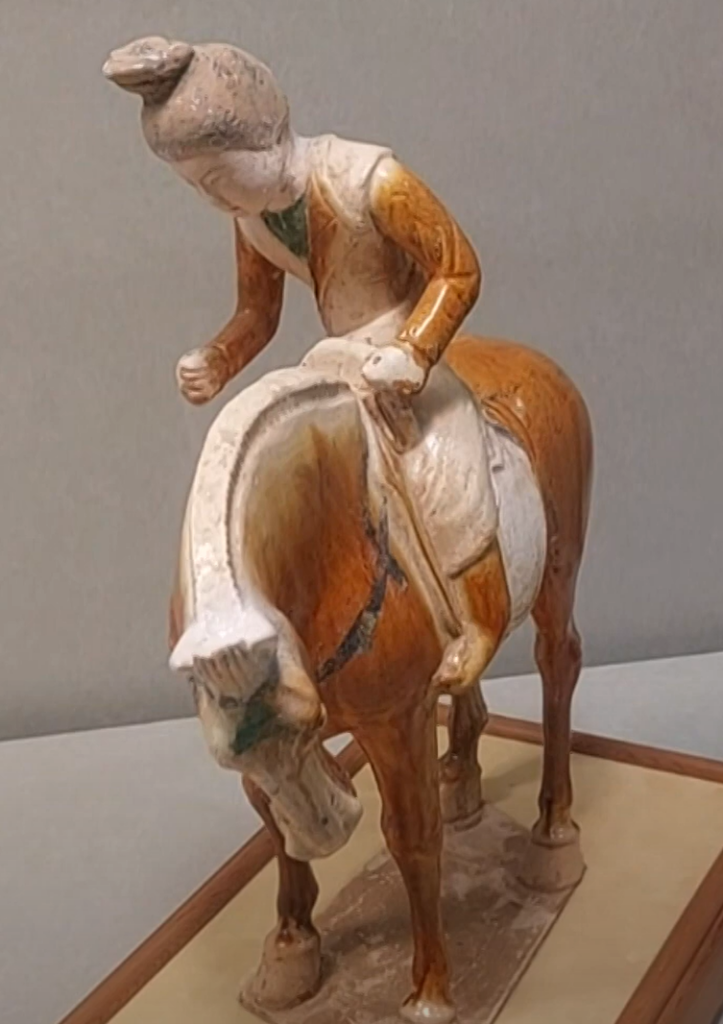

2nd Floor – “White Porcelain Baby Pillow”(17) 2樓-白瓷嬰兒枕(17)
Certainly! This little boy is a white porcelain figurine crafted during the Song Dynasty in the Ding kiln. Can you guess what function this adorable little boy serves?
好的~這個小男孩是宋代的定窯燒製的白瓷,猜猜看這個可愛的小男孩是做甚麼功能呢?
That’s correct! He is a pillow. This adorable baby pillow, made from white porcelain during the Song Dynasty, is a classic piece of art.
是的! 他是枕頭,這個可愛的嬰兒枕,是宋代白瓷的的經典之作。
Klook.com2nd Floor – “Introduction to Ru Kiln” 2樓-汝窯的介紹
“Ru Kiln has very few renowned pieces, with just over 70 known worldwide. Ru Kiln is famous for its celadon ceramics, known for their warm and lustrous sky-blue color, making it the top kiln of the Song Dynasty. It was only in production for about 20 years, and the Palace Museum (Forbidden City) houses 21 pieces, making it the world’s largest collection.”
汝窯的傳世作品極少,全世界只有70多件,汝窯屬於青瓷,以色澤溫潤的天青色出名,是宋代第一名窯。只燒製了約20年,故宮就擁有21件,是世界之冠。
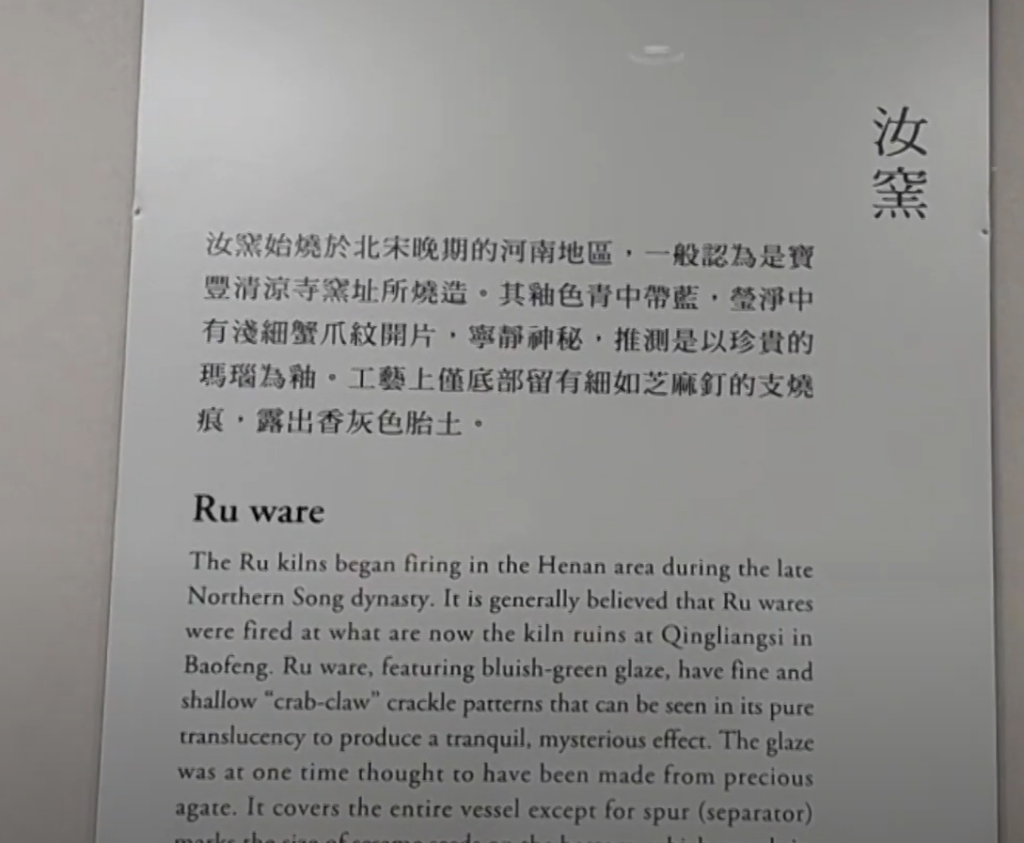

2nd Floor – “Lotus-Shaped Warm Bowl”(18) 2樓-蓮花式溫碗(18)
“In the process of firing ceramics, as they cool from high to low temperatures, the clay and the glaze applied on the surface contract at different rates, causing cracks to appear, known as ‘crazing.’ Originally a flaw, it occasionally results in unintended beauty.”
瓷器在燒製的過程中,從高溫降到低溫時,由於瓷土和塗在外層的釉收縮度不同,一鬆一緊,就會產生裂紋,這種裂紋叫”開片”。原本是瑕疵,但偶爾也會列出意外之美。
“A warming bowl is an ancient vessel used for heating wine. To use it, hot water is poured into the bowl, and then the wine pot is placed inside, allowing it to heat indirectly. There is only one lotus-shaped warming bowl like this in the entire world. Just look at how beautiful this lotus is.”
溫碗是古代人用來溫酒的器皿,使用時,先把熱水倒入碗中,再把酒壺放入碗中,就可以隔水加熱,蓮花溫碗全世界就只有這一件,你看多麼漂亮的蓮花。
2nd Floor – “The unadorned Narcissus basin”(19) 2樓-青瓷無紋水仙盆(19)
“The unadorned Narcissus basin in celadon is the only existing piece from the Ru Kiln collection without any cracks, perfectly flawless. Its color is the finest, resembling the blue sky after the rain.”
青瓷無紋水仙盆是現存汝窯作品中,唯一沒有裂紋的作品,完美無瑕。它的顏色就是極品中的雨過天青色。
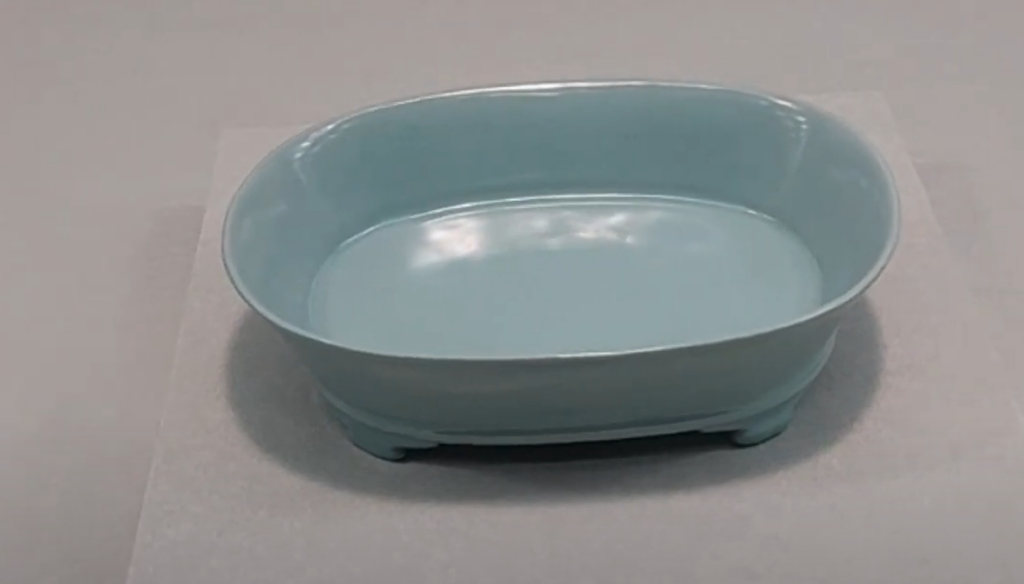

2nd Floor – “Sky-Blue Glazed Ruyi Pillow”(20) 2樓-天青釉如意枕(20)
“Guess what this piece was used for?”
猜猜看,這件作品是做甚麼用途的呢?
2nd Floor – “Sanskrit Ladle”(21) 2樓-梵文勺(21)
“This is the only surviving porcelain ladle from the Ming Dynasty’s Yongle period, consisting of a ‘Blue and White Lotus Sanskrit Ladle’ and a ‘Purple Sandalwood Goose-Shaped Stand.’ The inscriptions inside are in Sanskrit.”
是明朝永樂時期唯一傳世的一件瓷質大勺,由「青花朵蓮梵文大杓」和「紫檀木鵝形托座」共同組成。裡面的文字示梵文。
2nd Floor – “Doucai chicken cups “(22) 2樓-鬥彩雞缸杯(22)
Currently, there are only 19 surviving Chenghua Chicken Cups worldwide, with the majority held by institutions such as the National Palace Museum in Taipei and the British Museum in London. Only three remain in private collections and are available on the market. They were primarily used as imperial drinking vessels.
目前全球存世的成化雞缸杯僅19件,其中大部分被臺北故宮博物院、倫敦大英博物館等機構收藏。屬私人收藏、能在市面上流通的只剩3件。主要作為御用酒杯。
The name “doucai” originated during the Ming Chenghua period, named after the ceramic production technique that combines overglaze five colors (wucai) and underglaze blue (qinghua), creating a vibrant interplay between overglaze and underglaze colors, hence the name “doucai,” which can be roughly translated as “competing colors.”
而鬥彩名字的由來,在明成化時期以制瓷的工藝方法取名,是將釉上五彩和釉下青花相結合,形成釉上、釉下彩繪互相爭奇鬥豔的因而名之。
Doucai chicken cups were produced during the Ming Dynasty using a technique where fine blue lines were first sketched on the outer surface of a cup with a diameter of about 8 centimeters. These cups were then glazed and fired at temperatures around 1300 degrees Celsius to form the base. Subsequently, they were fired again at a lower temperature with red, green, yellow, and other colors to fill in the reserved blue patterns.
鬥彩雞缸杯燒製於明代,作法是在直徑約8公分的杯子外壁上,先用青花細線淡描出紋飾的輪廓線後,上釉入窯經1300度左右的高溫燒成胎體,然後再用紅、綠、黃等色填滿預留的青花紋飾中二次入窯低溫焙燒。
Behind this cup lies a love story. During the reign of Emperor Chenghua, who was not particularly fond of anyone, there was one person who captured his heart – Consort Wan, who was 17 years his senior. Consort Wan had a deep passion for porcelain, so to win her affection, Emperor Chenghua ordered the special production of the chicken cup in Jingdezhen. Inside the cup, there are depictions of a rooster, a hen, and their chicks, symbolizing the image of a happy family, all designed to delight Consort Wan.
杯子背後有一個愛情故事,成化皇帝長大之後誰也不愛,獨鍾將他帶大,整整大了17歲的萬貴妃;因為萬貴妃十分鍾愛瓷器,為了博取她的歡心,成化帝下令景德鎮特別燒製雞缸杯,裡頭有公雞、母雞與小雞,給萬貴妃一個美好家庭的想像。
In 2014, a Doucai chicken cup set a record in the world of Chinese porcelain auctions by selling for 35 million US dollars.
在2014年曾創下中國瓷器世界拍賣紀錄,一只鬥彩雞缸杯拍賣出3500萬美金。
2nd Floor – “Blue and White Dragon Pattern Celestial Globe Vase “(23) 2樓-青花龍紋天球瓶(23)
Chinese blue and white porcelain, widely cherished and admired around the world, includes a type of spherical, bulging vessel known as the “heavenly sphere vase” due to its resemblance to celestial bodies in the sky.
中國的青花瓷,流傳廣泛,深受世人賞愛。此類球形鼓腹器名稱因似天上星球而名「天球瓶」。
2nd Floor – “Whirling heart vase “(24) 2樓-游魚轉心瓶(24)
This is an exquisite plaything from the Qing Dynasty, owned by Emperor Qianlong, known as the “whirling heart vase.” Simply by turning the neck of the vase, the fish inside come to life, seemingly swimming gracefully among aquatic plants. It’s a creative and beautifully painted toy.
這是清朝乾隆皇帝的高級玩具,叫做轉心瓶,只要轉動瓶口,底下的游魚就會動起來,好像在水草之間游過來、游過去,充滿創意又有美麗彩繪的玩具。
The “whirling heart vase” can rotate freely because it’s divided into an outer and an inner vase. The outer vase can be disassembled into two parts, and the inner vase can be as well. These four separate components are fired individually before being meticulously assembled and fused together. This process demands a high level of precision to ensure a seamless fit and smooth rotation.
轉心瓶可以自由轉動,因為瓶子有分為外平和內瓶,外瓶可以拆分為2個部分,內瓶也是,這四個部分分開燒製,再組裝、燒黏起來,難度非常高。要很精準,才能合得上,轉得動。
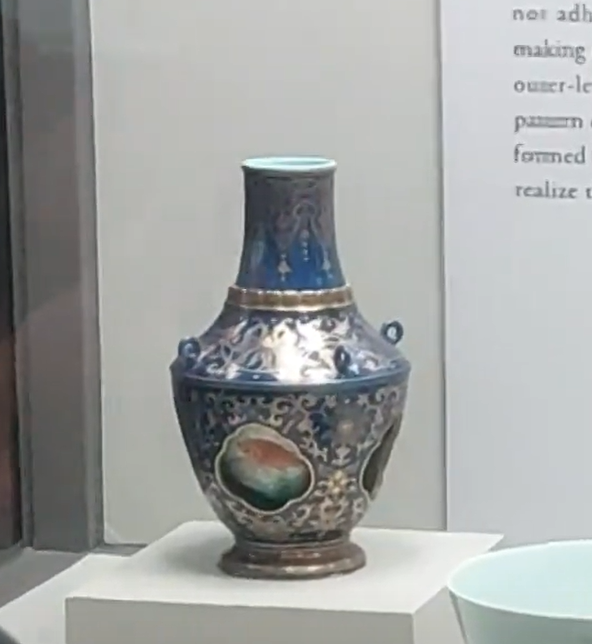

The Taipei National Palace Museum Classic Artifact Introduction Route – 1st Floor 台北故宮博物院經典文物集瓊藻介紹路線-1樓
“The classic guided tour of the Taipei National Palace Museum has finally reached the 1st floor. It took nearly 50 minutes to explore the 3rd and 2nd floors, and now we have these remaining collections, which are rare and precious items.”
台北故宮博物院的經典導覽終於來到1樓了,應該也花了近50分鐘導覽了3樓和2樓,剩最後這些收藏品就是珍玩類。
1st Floor – “Filigree Cloisonné Duck “(25) 1樓-掐絲珐瑯鴨子(25)
Enamelware is a craft that involves applying enamel glaze to a metal base and firing it. The incense burner is shaped like a proud-looking goose or duck and features elegant design, likely dating back to the Ming Dynasty in the early sixteenth century. It has a copper body, and the lid and body are fitted together in the abdomen. Incense smoke flows out through the neck of the bird from its mouth.
琺瑯器是將琺瑯釉藥塗覆在金屬胎燒製而成的工藝。香薰為昂首雁鴨造型,型制優美,應為明代、十六世紀前期文物。銅胎,爐蓋與器身在腹部套合,香煙經由鳧頸自口溢出。
1st Floor – “East pearls “(26) 1樓-東珠(26)
In ancient times, to distinguish the ranks of officials, decorations on their hats were used as identifiers. For instance, on the Emperor’s hat, there were adornments such as 15 East pearls, a privilege reserved exclusively for the Emperor.
在古時候要區分官階大小,會從帽子上的裝飾來識別,像這頂皇帝戴的帽子上,就裝飾了只有皇帝才能使用的15顆東珠。
East pearls, pearls of emperors. East pearls are rare and precious pearls produced by freshwater mussels in the northeastern region of China, particularly around the Black Dragon River (Heilongjiang).
東珠,帝王之珠。東珠是中國東北方黑龍江一帶,河蚌所生的珍珠,產量稀少,特別珍貴。
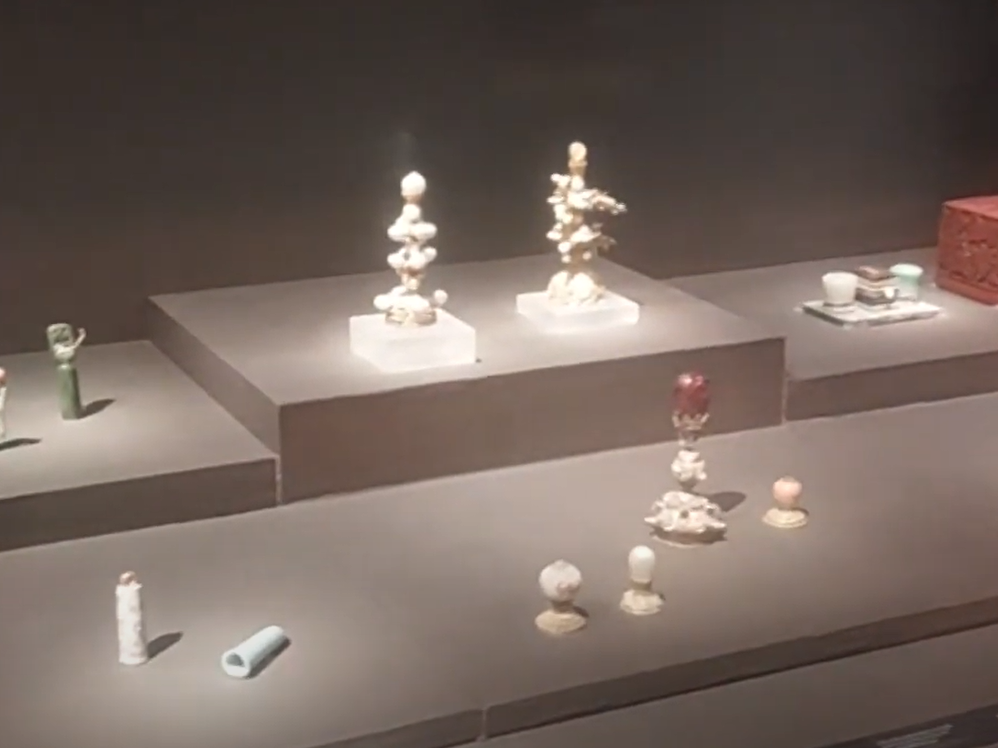

1st Floor – “Ruyi “(27) 1樓-如意(27)
A “ruyi” is an auspicious symbol, crafted from materials like gold, jade, bamboo, or bone. It is designed with a head resembling a lingzhi mushroom or cloud shape and has a slightly curved handle. Ruyi can be used for pointing or as decorative items. During the Qing Dynasty, emperors and empresses bestowed ruyi as gifts to royal officials. When selecting a bride for the emperor, if a ruyi was placed in a woman’s hands, it symbolized that she would become the empress.
“如意”一種象徵祥瑞的器物,用金、玉、竹、骨等製作,頭靈芝形或雲形,柄微曲,供指劃用或玩賞。清代的皇帝、皇后用如意作為賞賜王公大臣之物;在皇帝選妃時,若將如意交入一人手中,那就意味著她將成為皇后。
1st Floor – “Ivory dragon-patterned puzzle ball”(28) 1樓-象牙套球(28)
This is an ivory dragon-patterned puzzle ball, there are two of them. The larger one has 24 layers, and the smaller one has 9 layers. Each layer can be rotated, it’s really amazing. The outer layer has 9 cloud dragons.
這個是象牙龍紋套球,有兩顆,大的這顆有24層,小的有9層,每一層都是可以轉動,真的是太厲害了。外層有9條雲龍。
The artisan first carves the ivory into a spherical shape, then from the surface to the center of the sphere, evenly carves out 14 long conical holes. Afterward, they use a right-angle knife to carve out each layer one by one from within the conical holes.
藝師先把象牙鑿成球形,再從球面往球心,平均挖出14個長長的錐形孔,再用直角刀深入錐形孔,一一鑿出每一層。


1st Floor – “Olive Pit Carving”(29) 1樓-橄欖核雕(29)
This is carved from an olive pit, and the patterns and figures inside are incredibly lifelike. The craftsmanship is outstanding.
這個是用橄欖核進行雕刻,裡面的紋路、人物都栩栩如生,技術超好。
1st Floor – “Kuixing”(30) 1樓-魁星(30)
Legend has it that Kuixing was originally a highly learned scholar, but due to his ugly appearance, he couldn’t pass the imperial examinations. He became frustrated and attempted to drown himself, but was saved by a turtle in the water. From then on, he transformed into the leader of the Big Dipper constellation, overseeing academic success and career advancement. He became a deity worshipped by the people.
傳說魁星原本是位很有學問的讀書人,只因長相醜怪,一直無法通過科舉考試,他憤而投水,卻被水中的鰲魚救起,從此化身為北斗七星之首,掌管科考文運和仕途亨通,成為民間供奉的神祇。
He holds the Big Dipper and a plum branch, standing on one leg atop the head of a jade turtle emerging from the waves, symbolizing the plum’s status as a leading flower and exclusive occupancy of the turtle’s head.
手持北斗七星和梅枝,單腳站立在龍頭魚身、湧現於波浪間的翠玉鰲魚頭上,隱含著梅為花魁、獨占鰲頭的意味。
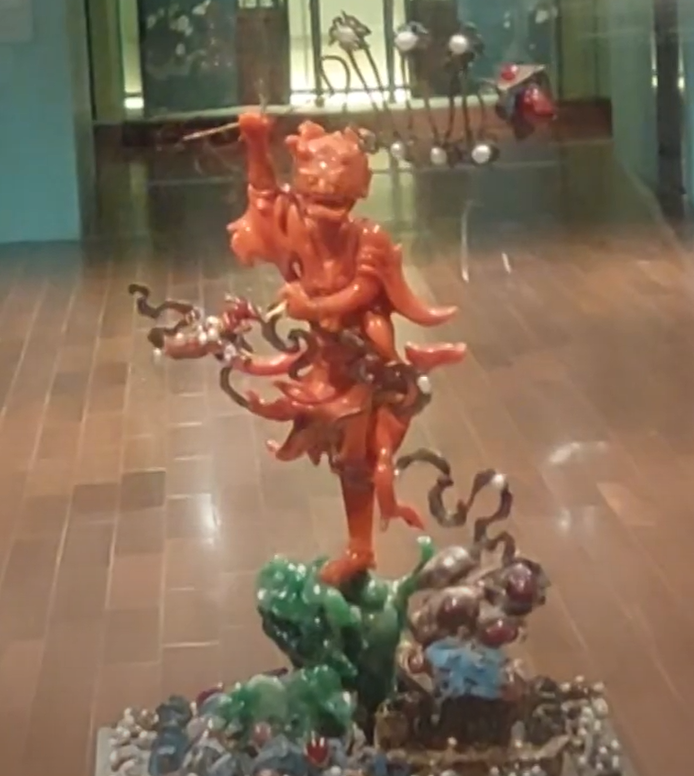

1st Floor – “Multipurpose Treasure Box”(31) 1樓-多寶格盒(31)
This is the Qing Dynasty emperor’s toy box, a small cabinet for the emperor to store and carry some precious toys, making it convenient for the emperor to bring along these treasures when traveling, allowing for easy enjoyment and play at any time.
這是清朝皇帝的玩具箱,皇帝收藏珍玩的小盒櫃,方便皇帝出遊時可以攜帶一些珍玩,隨時想欣賞和把玩。
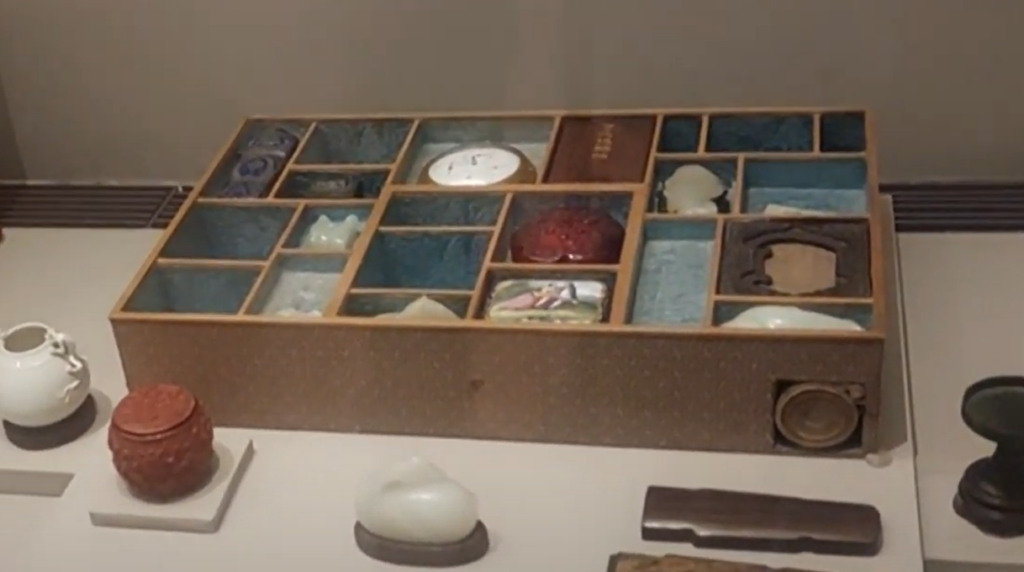

Conclusion 結論
“The Taipei National Palace Museum is truly a must-visit attraction, and if you aim to see every artifact, I believe it would take more than three days and nights. Therefore, I provide a brief introduction to 31 selected artifacts on the classic route to give you a preliminary understanding of the museum, ensuring your visit is worthwhile. If you have foreign friends visiting Taipei and need a guide to take you to the Taipei National Palace Museum, feel free to contact me. You’re welcome, and don’t hesitate to get in touch!”
台北故宮博物院,真的是一定要去走訪的景點,若要全部看完所有文物,我相信三天三夜都不夠用的,所以透過經典路線31件文物的簡單介紹,讓大家可以對台北故宮博物院有一點初步的認識,也不虛此行。若外國朋友來台北玩,需要麥克帶您去台北故宮博物院,歡迎您,不要客氣請跟我聯繫喔。
延伸文章~
旅市假期~尋找適合您的跟團行程
✴歡迎加入旅遊麥克GO世界FB粉絲專頁👇

